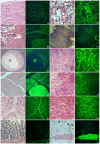Transgene expression is associated with copy number and cytomegalovirus promoter methylation in transgenic pigs
- PMID: 19688097
- PMCID: PMC2723931
- DOI: 10.1371/journal.pone.0006679
Transgene expression is associated with copy number and cytomegalovirus promoter methylation in transgenic pigs
Abstract
Transgenic animals have been used for years to study gene function, produce important proteins, and generate models for the study of human diseases. However, inheritance and expression instability of the transgene in transgenic animals is a major limitation. Copy number and promoter methylation are known to regulate gene expression, but no report has systematically examined their effect on transgene expression. In the study, we generated two transgenic pigs by somatic cell nuclear transfer (SCNT) that express green fluorescent protein (GFP) driven by cytomegalovirus (CMV). Absolute quantitative real-time PCR and bisulfite sequencing were performed to determine transgene copy number and promoter methylation level. The correlation of transgene expression with copy number and promoter methylation was analyzed in individual development, fibroblast cells, various tissues, and offspring of the transgenic pigs. Our results demonstrate that transgene expression is associated with copy number and CMV promoter methylation in transgenic pigs.
Conflict of interest statement
Figures





Similar articles
-
Transcriptional activities of human elongation factor-1α and cytomegalovirus promoter in transgenic dogs generated by somatic cell nuclear transfer.PLoS One. 2020 Jun 3;15(6):e0233784. doi: 10.1371/journal.pone.0233784. eCollection 2020. PLoS One. 2020. PMID: 32492024 Free PMC article.
-
Effect of trichostatin A and 5-Aza-2'-deoxycytidine on transgene reactivation and epigenetic modification in transgenic pig fibroblast cells.Mol Cell Biochem. 2011 Sep;355(1-2):157-65. doi: 10.1007/s11010-011-0849-7. Epub 2011 May 4. Mol Cell Biochem. 2011. PMID: 21541675
-
Silencing of fat-1 transgene expression in sheep may result from hypermethylation of its driven cytomegalovirus (CMV) promoter.Theriogenology. 2012 Sep 1;78(4):793-802. doi: 10.1016/j.theriogenology.2012.03.027. Epub 2012 Apr 26. Theriogenology. 2012. PMID: 22541322
-
Position effect variegation and epigenetic modification of a transgene in a pig model.Genet Mol Res. 2012 Feb 16;11(1):355-69. doi: 10.4238/2012.February.16.1. Genet Mol Res. 2012. PMID: 22370938
-
Unstable expression of transgene is associated with the methylation of CAG promoter in the offspring from the same litter of homozygous transgenic mice.Mol Biol Rep. 2014 Aug;41(8):5177-86. doi: 10.1007/s11033-014-3385-1. Epub 2014 May 8. Mol Biol Rep. 2014. PMID: 24804614
Cited by
-
Long-term (10-year) monitoring of transposon-mediated transgenic cattle.Transgenic Res. 2024 Oct;33(5):503-512. doi: 10.1007/s11248-024-00401-0. Epub 2024 Aug 28. Transgenic Res. 2024. PMID: 39196515 Free PMC article.
-
Transgenic pigs with pancreas-specific expression of green fluorescent protein.J Reprod Dev. 2014;60(3):230-7. doi: 10.1262/jrd.2014-006. Epub 2014 Apr 21. J Reprod Dev. 2014. PMID: 24748398 Free PMC article.
-
DNMT 1 maintains hypermethylation of CAG promoter specific region and prevents expression of exogenous gene in fat-1 transgenic sheep.PLoS One. 2017 Feb 3;12(2):e0171442. doi: 10.1371/journal.pone.0171442. eCollection 2017. PLoS One. 2017. PMID: 28158319 Free PMC article.
-
SVCT2 Is Expressed by Cerebellar Precursor Cells, Which Differentiate into Neurons in Response to Ascorbic Acid.Mol Neurobiol. 2018 Feb;55(2):1136-1149. doi: 10.1007/s12035-016-0366-5. Epub 2017 Jan 17. Mol Neurobiol. 2018. PMID: 28097475
-
The construction and expression of lysine-rich gene in the mammary gland of transgenic mice.DNA Cell Biol. 2012 Aug;31(8):1372-83. doi: 10.1089/dna.2011.1599. Epub 2012 May 11. DNA Cell Biol. 2012. PMID: 22577831 Free PMC article.
References
-
- Houdebine LM. The methods to generate transgenic animals and to control transgene expression. Biotechnology. 2002;98:145–160. - PubMed
-
- Park KW, Cheong HT, Lai L, Im GS, Kühholzer B, et al. Production of nuclear transfer-derived swine that express the enhanced green fluorescent protein. Anim Biotechnol. 2001;12:173–181. - PubMed
-
- Phelps CJ, Koike C, Vaught TD, Kühholzer B, Samuel M, et al. A transgenic pig expressing the enhanced green fluorescent protein produced by nuclear transfer using colchicine-treated fibroblasts as donor cells. Science. 2003;299:411–414.
-
- Gubin AN, Reddy B, Njoroge JM, Miller JL. Long-term Retroviral-mediated stable expression of Green Fluorescent Protein in mammalian cells. Biochem Biophys Res Commun. 1997;236:347–350. - PubMed
Publication types
MeSH terms
Substances
LinkOut - more resources
Full Text Sources
Other Literature Sources

